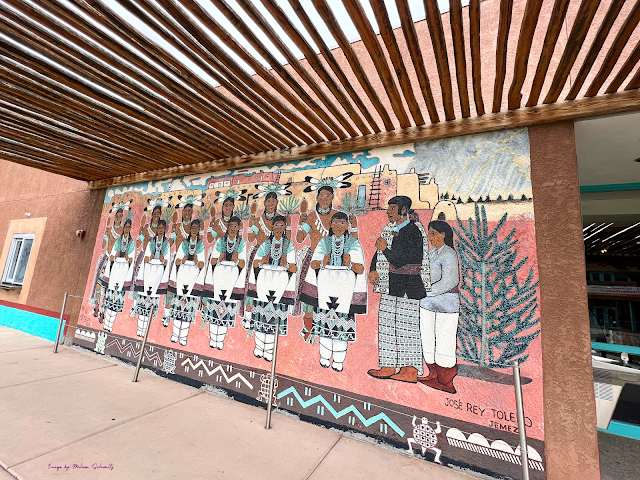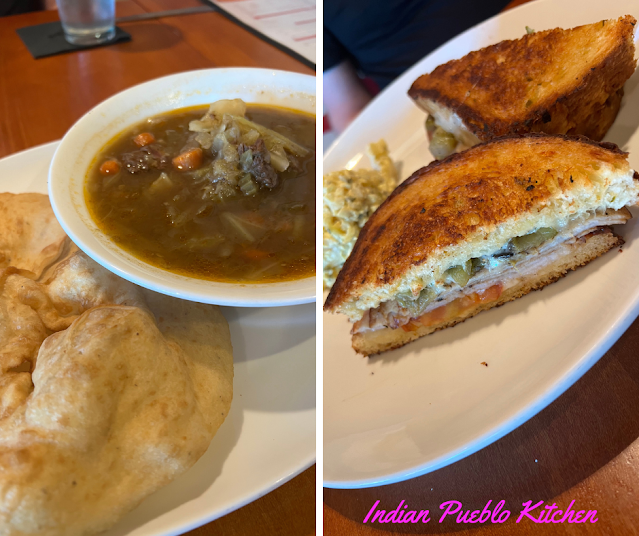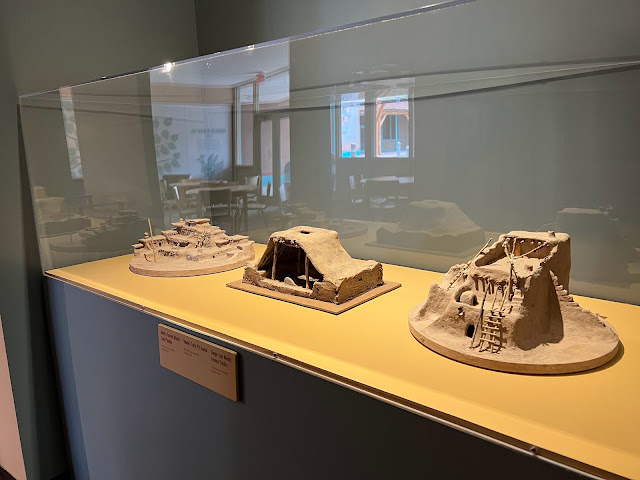The Indian Pueblo Cultural Center in Albuquerque, New Mexico lays the foundation for experiencing and celebrating the history and culture of the 19 Pueblos of New Mexico. Creative learning throughout the museum introduces the Pueblos engaging visitors and actively wrapping them in the story.
The museum includes a mosaic of both an extensive permanent exhibit and smaller temporary exhibits. The permanent exhibit is immediately impactful and guided me through the history of the Pueblos. The center is located at the heart of 80 acres of land that is owned and governed by the 19 Pueblos. It is also the former location of the Albuquerque Indian School. A moving exhibit within the museum reflects upon the tragic history of the Indian schools that we are still learning more about.
Through the Generations
The museum winds visitors through the history of the Pueblos focusing on art, culture, agriculture, symbolism, spirituality, history, and current life. During my visit, I felt welcomed along the journey of the Pueblos and felt the pride in heritage along the path. The Pueblo spirit can be felt throughout the center as it is through New Mexico. I am grateful to have been invited along this journey.
The tie between the Pueblo and the Earth is quite strong and visitors to the museum quickly develop an appreciation for that bond. The Pueblo story begins when the ancestors emerged up onto the Earth through an opening from the underworlds. The land guided where the ancestors would settle. Mountains, cliffs, and rivers are sacred and provide sites for ceremonies as well as a sense of place. As I observed Pueblo art, this bond with the Earth comes forth telling the story of the Pueblo.
 |
| Art at the Indian Pueblo Cultural Center tells the story of the Pueblo and especially highlights their tie with nature. |
The word 'pueblo' derives from Spanish and means village. The original Pueblo lived in pit houses partially dug into the ground entering them through an opening and a ladder. Eventually, the Pueblo would craft homes from stone. Pueblo would then develop creating adobe bricks for building homes. Today, you can visit the Pueblos, view some of the architecture, and experience the culture. Each Pueblo has its own sovereign government and you will need to contact the one you would like to visit to learn the rules for a visit.
Why Adobe?
Adobe is crafted from Earth's natural materials -- mud and straw baked in the sun. Layered with earthen mortar, a structure's adobe walls absorb heat during the day and release it slowly at night. This keeps the home cool during the day and warm in the evening. Adobe also is an earth-friendly, sustainable building material. Deriving material from nature, adobe also connects Pueblos to the Earth making homes sacred spaces.
Learning About the Pueblo
Each Pueblo is known for its own arts including weaving, basketry, pottery, jewelry, and more. Some of these traditions are over thousands of years old. I learned so much about the Pueblo arts. The weaving together of creation and nature spoke to me as someone who also feels a strong connection to nature.
Interesting Fact: The Pueblo use the fibers of the yucca plant to make paintbrushes. Yucca fibers can also be used to make baskets, sandals, or rope.
Along my journey, I learned about the Pueblo after the arrival of the Spanish. The first Spanish soldiers arrived in 1540 with Francisco Vásquez de Coronado. Settled in 1798, San Juan de los Caballeros was the first Spanish settlement. The Spanish created missions throughout New Mexico. Increasingly, the Spanish became more aggressive in converting Pueblo to Christianity. In 1680, the Pueblo revolted and were successful on pushing the Spanish out of New Mexico for 12 years.
Contact with the Spaniards and eventually the Americans would have a lasting impact. The Indian Pueblo Cultural Center also addresses the tragic experience of Indian Boarding Schools. Despite these efforts to subjugate Pueblo culture, we can see that Pueblo culture blossoms today. I am very grateful that Pueblo culture is still vibrant and that the Indian Pueblo Cultural Center embraces teaching about the New Mexico Pueblos.
Feeling the Energy of the Murals at Indian Pueblo Cultural Center
 |
| Turtle Dance by José Rey Toledo of the Jemez Pueblo |
The central square of the museum displays incredible murals crafted by Pueblo artists. Full of life, each mural depicts the roles of the harvest, seasons, agriculture, and animals in the Pueblo life. Exiting the indoor portion of the museum, the murals immediately embraced me within the world of Pueblo life.
One of my favorite murals, Turtle Dance by José Rey Toledo of the Jemez Pueblo, depicts a ceremonial dance performed to bring forth the blessing of rain. As you can see, the mural breathes life and energy into the square. The square offers a focal point of engagement at the center and provides a location for many activities including Pueblo dances.
Eating at Indian Pueblo Kitchen
Indian Pueblo Kitchen presents a culinary experience tasting the flavors of Pueblo cuisine. Dishes are created by a team of Pueblo heritage and highlight cultural cooking traditions and ingredients. We ate at Indian Pueblo Kitchen and can say that it was one of the best meals we had in Albuquerque. For my lunch, I enjoyed bison stew with an incredible fry bread -- you have to get the fry bread! My husband devoured the Pueblo Turkey Melt. Indian Pueblo Kitchen has very deservedly won many accolades. We would definitely return on a future trip to Albuquerque.
 |
| Delicious bison stew, fry bread, and a Pueblo turkey melt at Indian Pueblo Kitchen. |
Indian Pueblo Cultural Center Gift Shop
The gift shop at the Indian Pueblo Cultural Center features the art of the Pueblo including jewelry, pottery, baskets and more. This is the ideal spot to pick up your made in New Mexico treasure to bring home.
Overall Experience at Indian Pueblo Cultural Center
Indian Pueblo Cultural Center unfolds an engaging journey learning about the Pueblo emphasizing their history, arts, and bond with nature. Multimedia experiences and events including dances further enrich the journey. Learning about the ancestral Pueblo people of New Mexico and the current Pueblos provides an incredible foundation for any visit to Albuquerque while fostering a true appreciation for Pueblo heritage. Thank you the Pueblo people for inviting me to explore your path.





Post a Comment